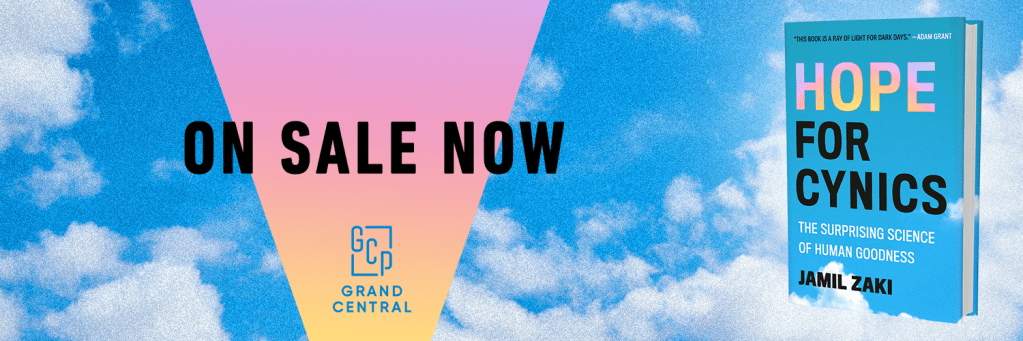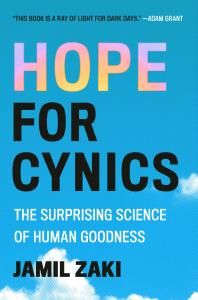HOPE FOR CYNICS – Read an excerpt

According to an ancient myth, hope arrived on earth as part of a curse. Prometheus stole fire from the gods, and Zeus avenged the theft with a “gift.” He commanded Hephaestus to mold the first woman, Pandora, and presented her to Prometheus’s brother. Pandora, in turn, was given a clay jar—which Zeus told her never to open. Curiosity got the better of her, she lifted the lid, and out flew all the world’s ills: sickness and famine for our bodies, spite and envy for our minds, war for our cities. Realizing her mistake, Pandora slammed the jar shut, leaving only hope trapped inside.
But what was it doing there in the first place, alongside our miseries? Some people believe hope was the jar’s only good, and trapping it further doomed us. Others think it fits in perfectly with the other curses. The philosopher Friedrich Nietzsche called hope “the most evil of evils because it prolongs man’s torment.” You might agree. Hope has been typecast as delusional and even toxic—causing people to ignore their problems and the world ’s.
Scientists think of hope differently. The psychologist Richard Lazarus wrote, “To hope is to believe that something positive, which does not pres- ently apply to one’s life, could still materialize.” In other words, hope is a response to problems, not an evasion of them. If optimism tells us things will get better, hope tells us they could. Optimism is idealistic; hope is prac- tical. It gives people a glimpse of a better world and pushes them to fight for it.
Any of us can practice hope. Emile did. He saw the same world most of us do, but instead of retreating into cynicism, he chose to work for peace, build community, and live his principles. To me and many who knew him, Emile’s positivity seemed supernatural. Temperament, experience, will, or some alchemy of all three graced him with a mind and a heart many of us could learn from.
This book is my attempt to spread his lessons. With his wife Stephanie’s support, I’ve spoken with Emile’s family, childhood friends, coaches, teammates, and colleagues. I’ve traveled to places that mattered to him and pored over notes he never got to share with the world. Through dozens of tear- ful, grateful conversations, I gained a deeper understanding of who Emile was and how he got that way. Then, unexpectedly, I began to experience his presence. When I felt snarky or cynical—which was often—I began hearing his voice: first occasionally, then often; first quietly, then clearly.
Shortly after his diagnosis, Emile wrote to Stephanie, “As a neuroscientist, I learned that our brains don’t really see the world, they just interpret it. So, losing my body is not really a loss after all! What I am to you is really a reflection of your own mind. I am, and always was, there, in you.” While writing this book, I’ve had the strange and solemn experience of witnessing Emile come alive inside my mind from beyond this world. He has taught me more than I could have imagined.
Here, he will teach you, too. Emile pursued peace the way doctors pursue healing. If illnesses are aberrations in the body’s function, Emile saw conflict and cruelty as diseases of social health. He and his colleagues diag- nosed the triggers that inspire hatred, and then designed psychological treatments to reduce conflict and build compassion.
Hope for Cynics will take a similar approach to our loss of faith in one another. You’ll soon be able to diagnose symptoms of cynicism in yourself and others, understand its causes, and realize how it contributes to countless social ills, from an epidemic of loneliness to the “Great Resignation” at workplaces around the world to the erosion of democracy itself.
Once we understand the illness, we can treat it. In this mission, Emile becomes less like the doctor and more like a miracle patient. If cynicism is a pathogen, he was unusually resistant to it. When someone avoids a wide-spread plague, we might test their genes or blood for clues about how to fight the disease. I’ve probed Emile’s life for choices and experiences that helped him practice hope.
In doing so, I’ve learned that one powerful tool he used to fight cynicism was skepticism: a reluctance to believe claims without evidence. Cynicism and skepticism are often confused for each other, but they couldn’t be more different. Cynicism is a lack of faith in people; skepticism is a lack of faith in our assumptions. Cynics imagine humanity is awful; skeptics gather information about who they can trust. They hold on to beliefs lightly and learn quickly. Emile was a hopeful skeptic, combining his love of humanity with a precise, curious mind.
This mindset presents us with an alternative to cynicism. As a culture, we are so focused on greed, hatred, and dishonesty that humanity has become criminally underrated. In study after study, most people fail to realize how generous, trustworthy, and open-minded others really are. The average person underestimates the average person.
If you’re anything like the average person, this hides some good news: People are probably better than you think. By leaning into skepticism—paying close attention rather than jumping to conclusions—you might discover pleasant surprises everywhere. As research makes clear, hope is not a naive way of approaching the world. It is an accurate response to the best data available. This is a sort of hope even cynics can embrace, and a chance to escape the mental traps that have ensnared so many of us.
Here, you will learn about decades of science on cynicism, trust, and hope, including work from my own lab, and meet people using hope like an axe to break down doors. We’ll meet a principal who turned around a “dangerous” middle school by empowering its students and a CEO who replaced his firm’s cutthroat culture with cooperation. A QAnon follower will discover that family means more to her than conspiracies, and a recluse in Japan will find his voice through art. In their stories, we will witness how our minds can evolve to strengthen communities and reimagine the future.
Throughout the book, I’ll also share strategies and habits to cultivate hopeful skepticism. If you want to go deeper, appendix A offers a practical guide. But if I’m going to ask you to fight cynicism, I should take my own advice. Recently, I’ve tried. Drawing from the science, I’ve rethought parenting, experimented with the media I consume, talked with more strangers, and tried to overcome my climate “doomerism.” Much of this work has been painful or awkward. But in fits and starts, it has changed me. I’ve watched my relationships strengthen, trust build, and optimism grow.
Cynicism often boils down to a lack of good evidence. Being less cynical, then, is simply a matter of noticing more precisely. I hope this book will help you witness the good in others and work toward the world most of us want.
The cynical voice inside each of us claims that we already know everything about people. But humanity is far more beautiful and complex than a cynic imagines, the future far more mysterious than they know.
Cynicism is a dirty pair of glasses more of us put on each year. I intend to help you take them off. You might be astonished by what you find.
Cynicism is making us sick, but Stanford Psychologist Dr. Jamil Zaki has the cure—a “ray of light for dark days” (Adam Grant, #1 New York Times bestselling author).
In 1972, half of Americans agreed that most people can be trusted; by 2018, only a third did. Different generations, genders, religions, and political parties all think human virtue is evaporating. Cynicism is an understandable response to a world full of injustice and inequality. But in many cases, it is misplaced. Dozens of studies find that people fail to realize how kind, generous, and open-minded others really are. Cynical thinking deepens social problems: when we expect the worst in people, we often bring it out of them.
We don’t have to remain stuck in this cynicism trap. Through science and storytelling, Jamil Zaki imparts the secret for beating back cynicism: hopeful skepticism—thinking critically about people and our problems, while honoring and encouraging our strengths. Far from being naïve, hopeful skepticism is a precise way of understanding others that can rebalance our view of human nature and help us build the world we truly want.
Amazon Editors’ Pick for Best Nonfiction Books of 2024
